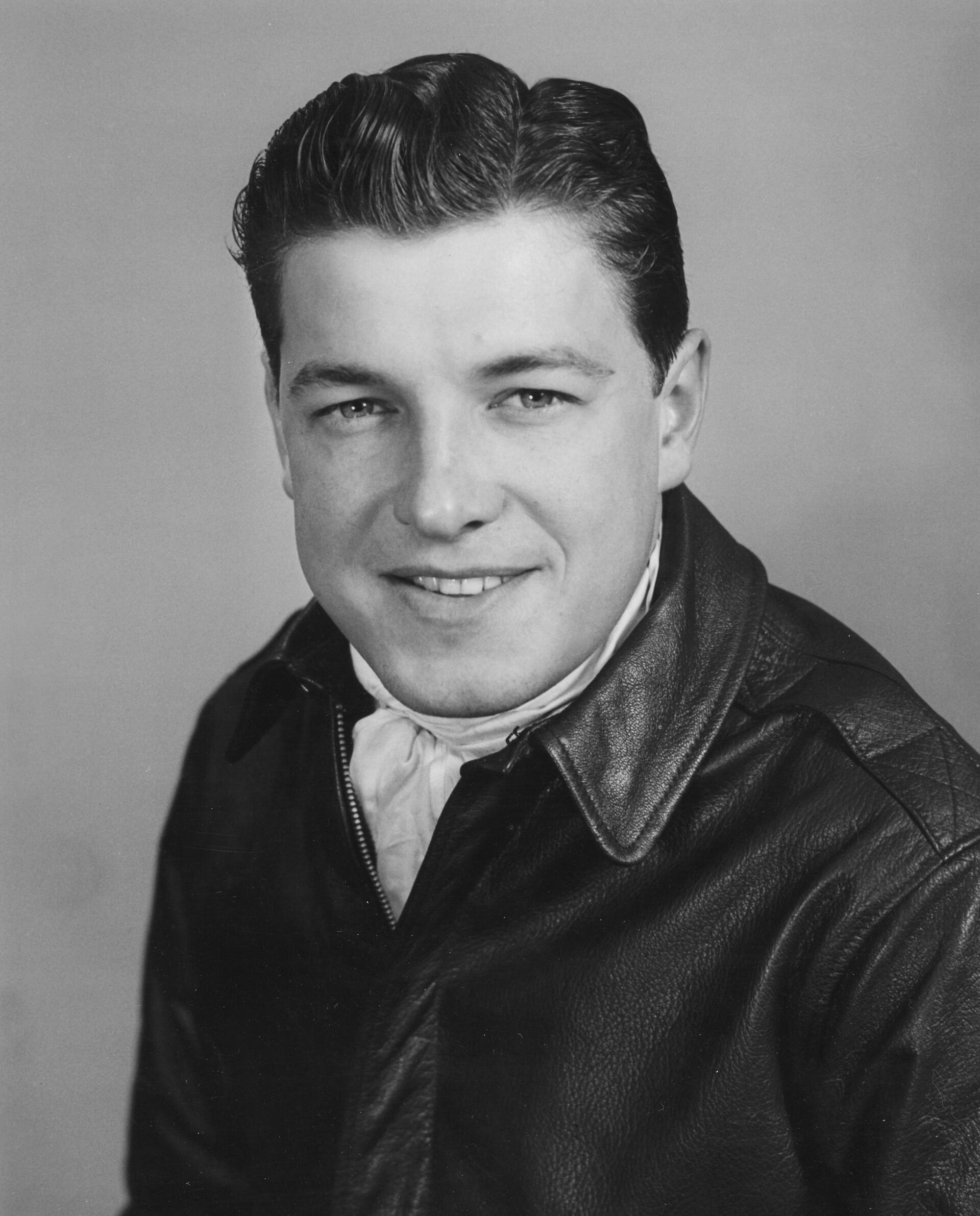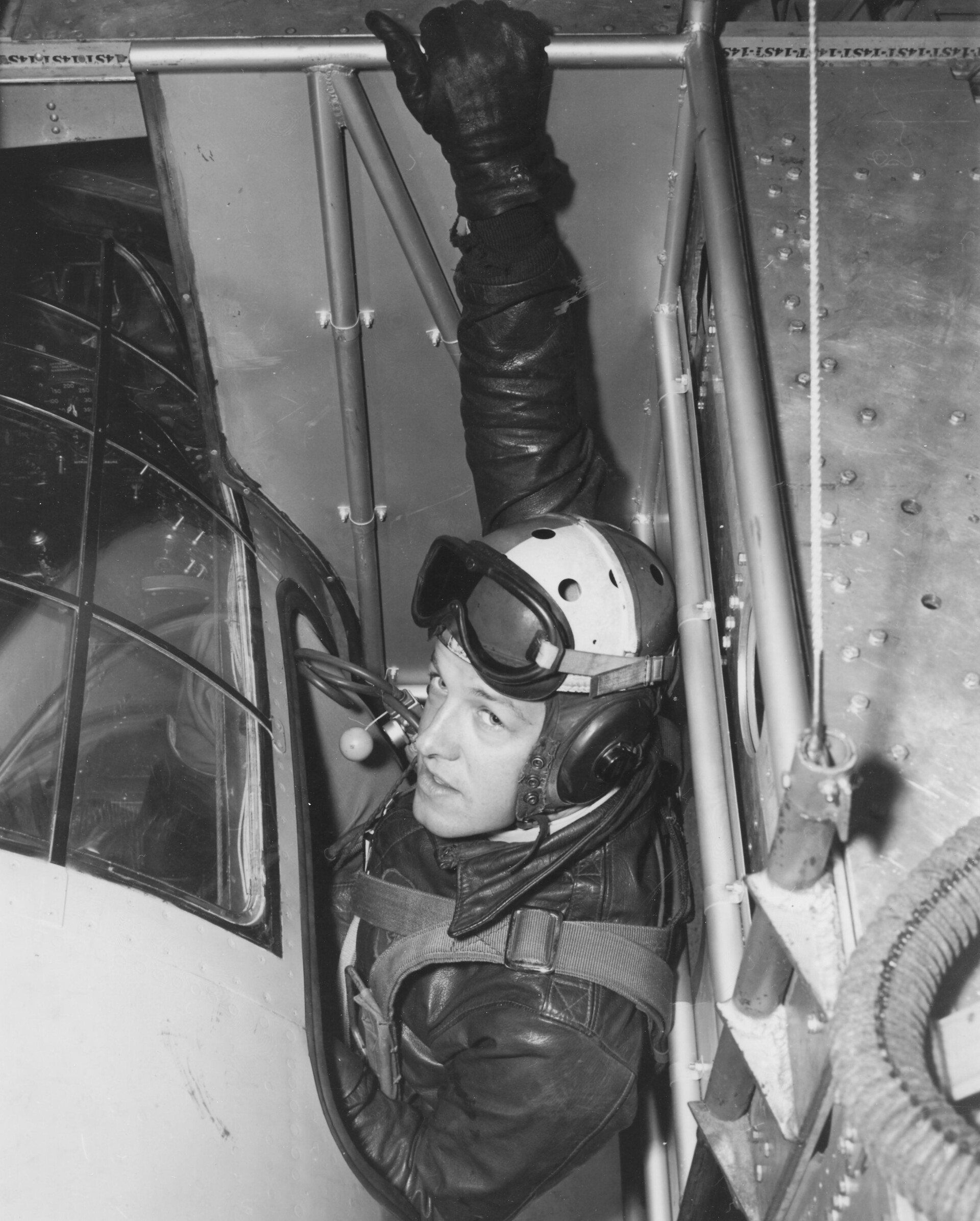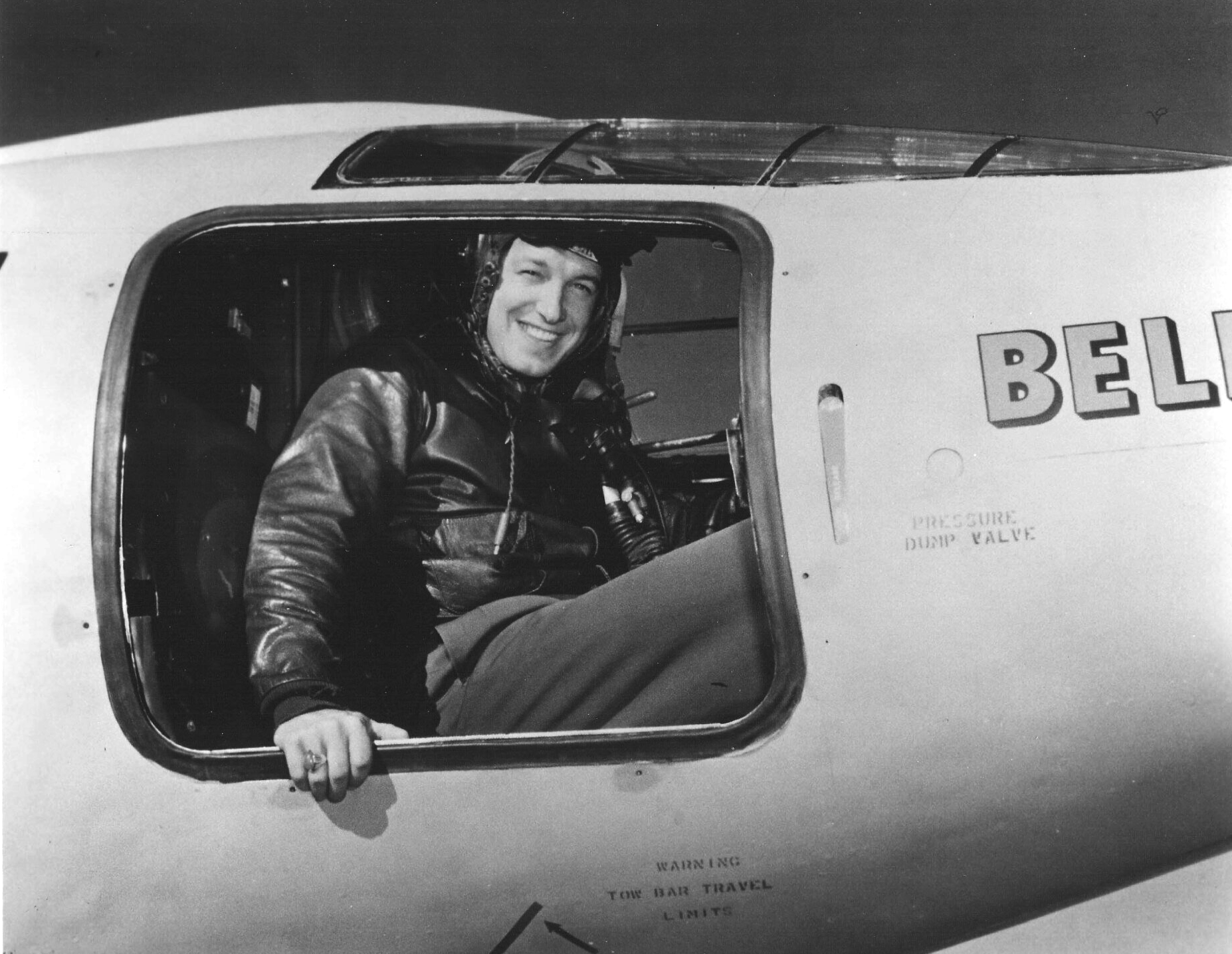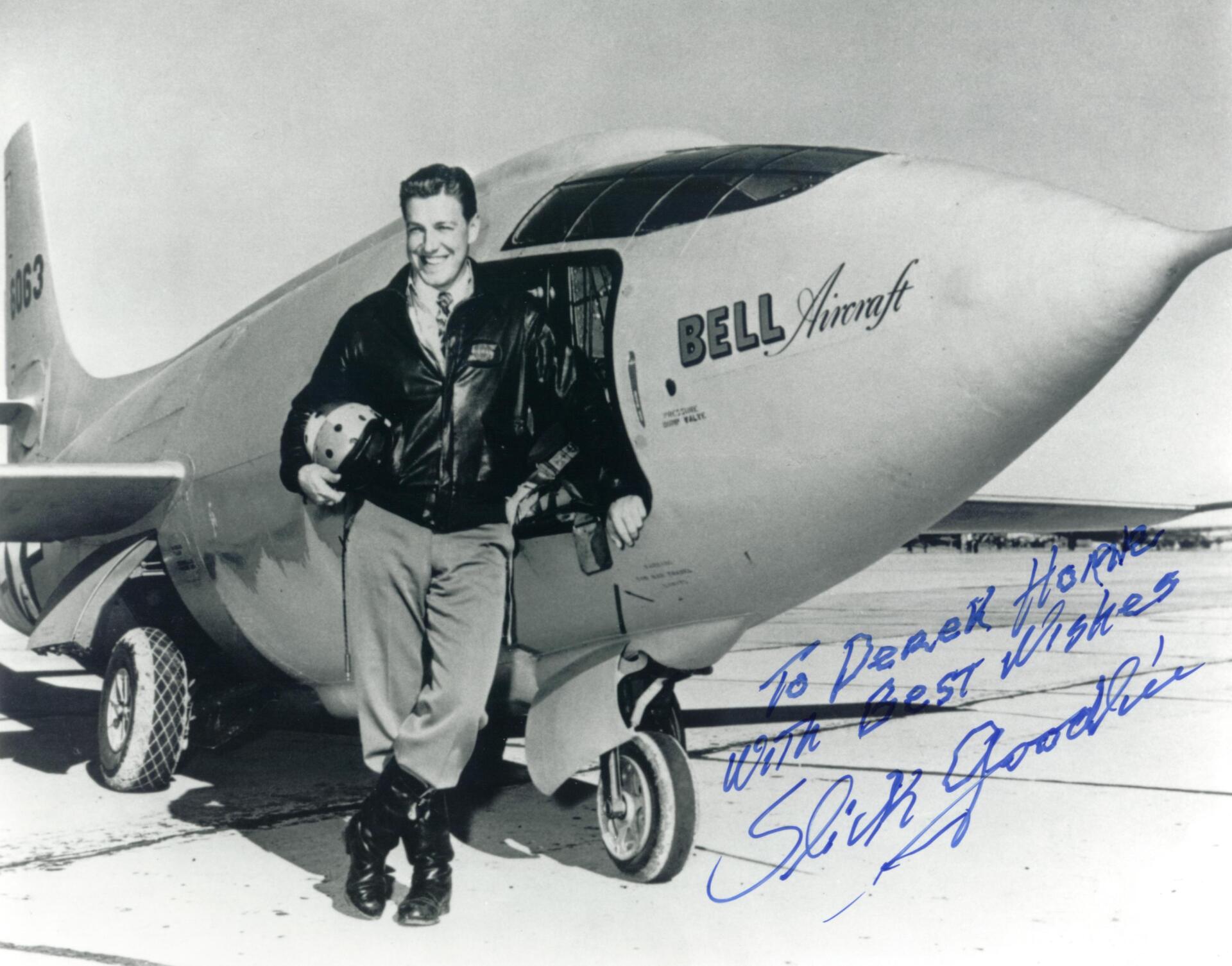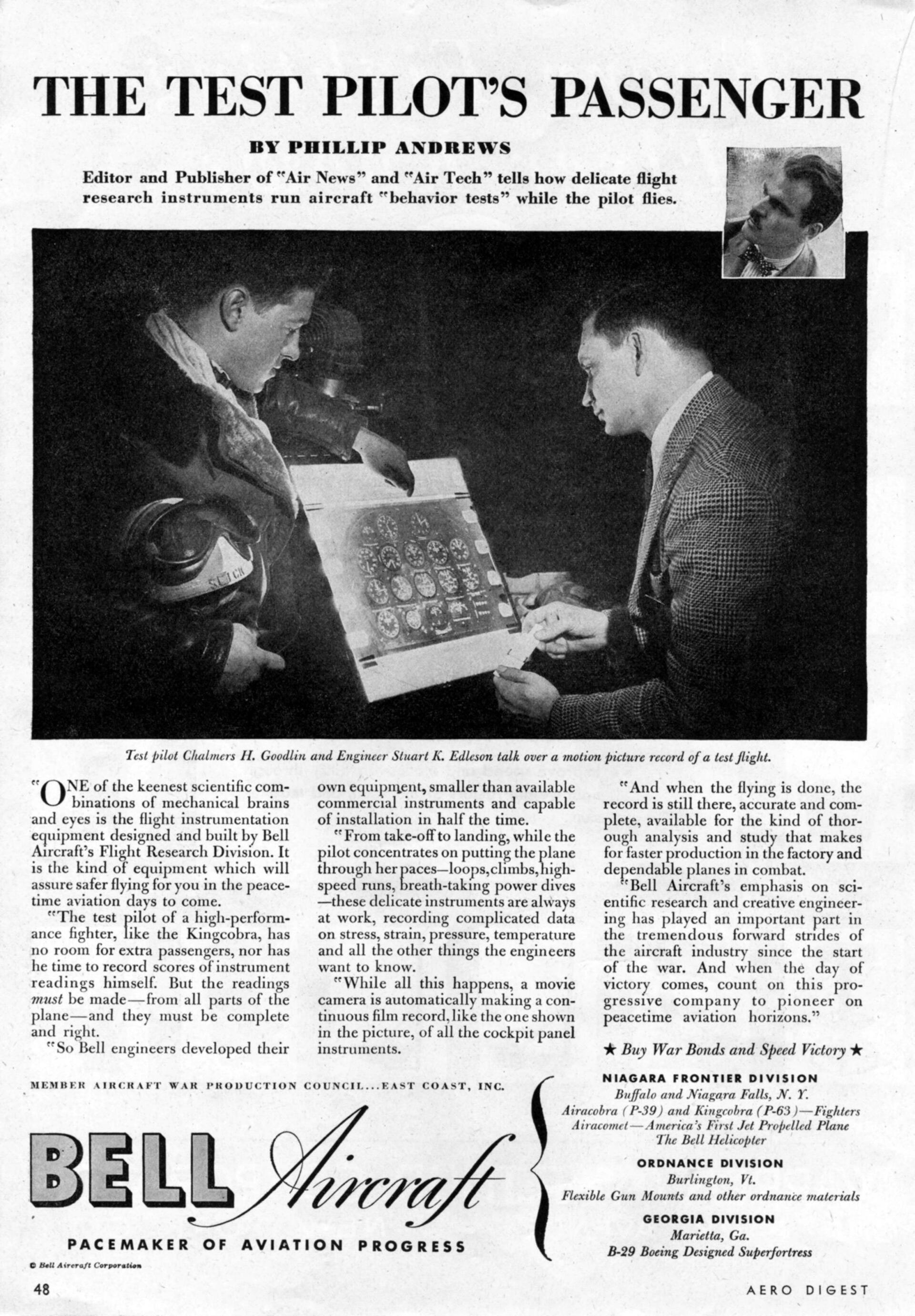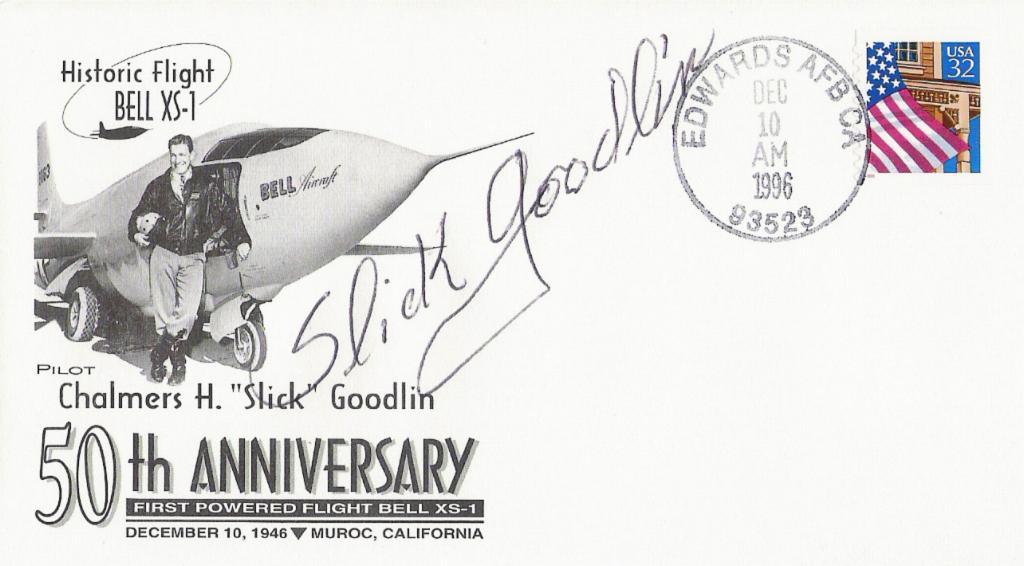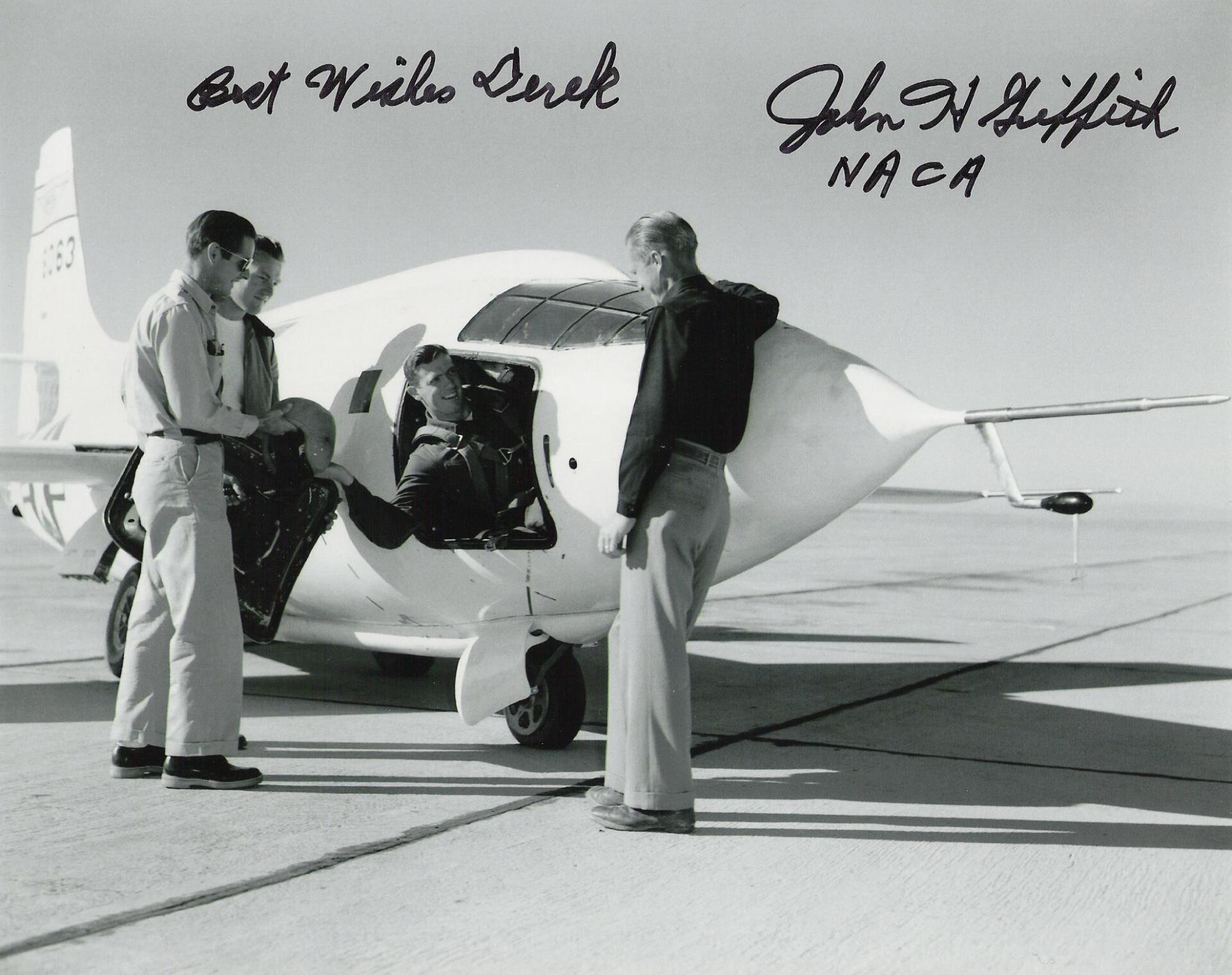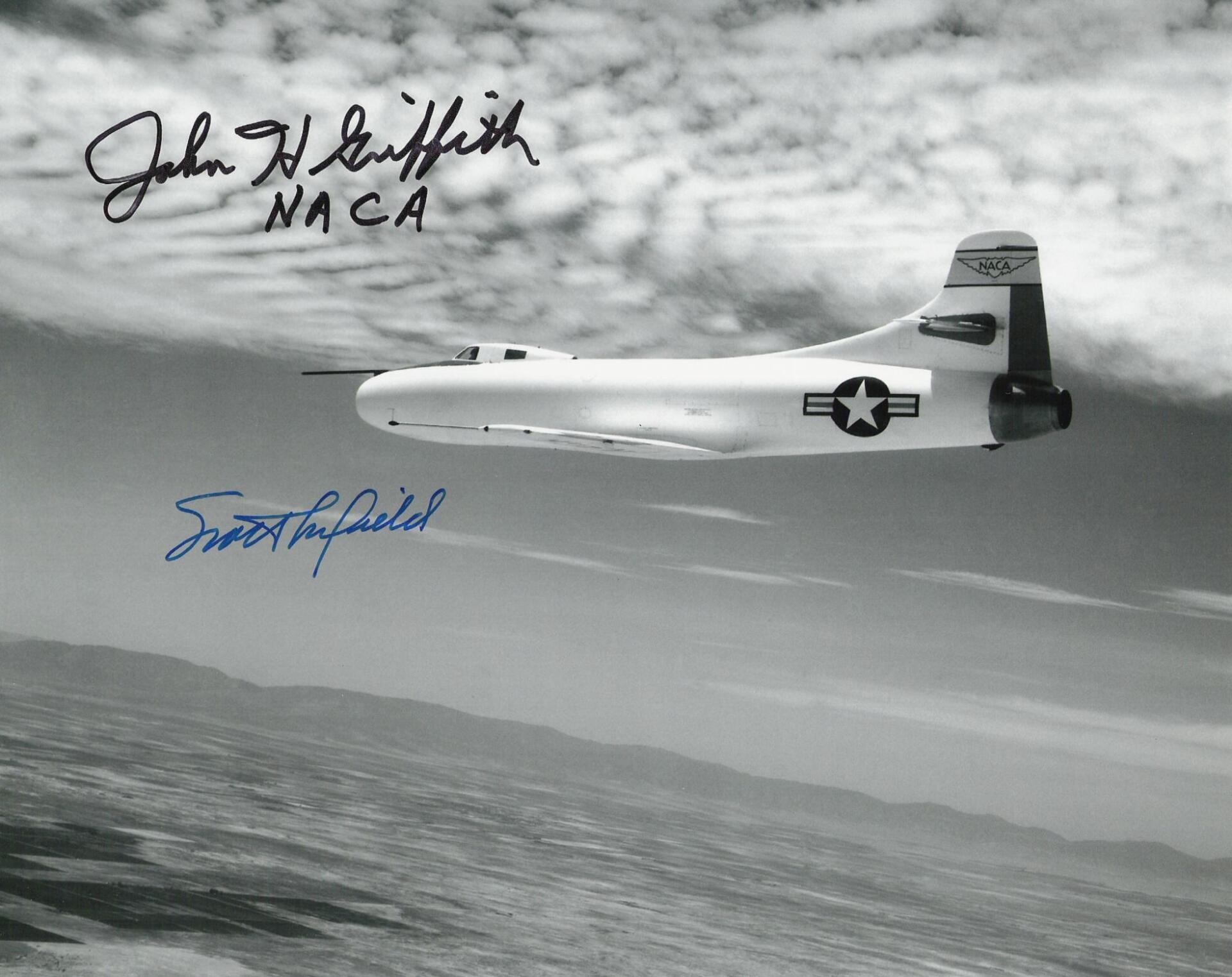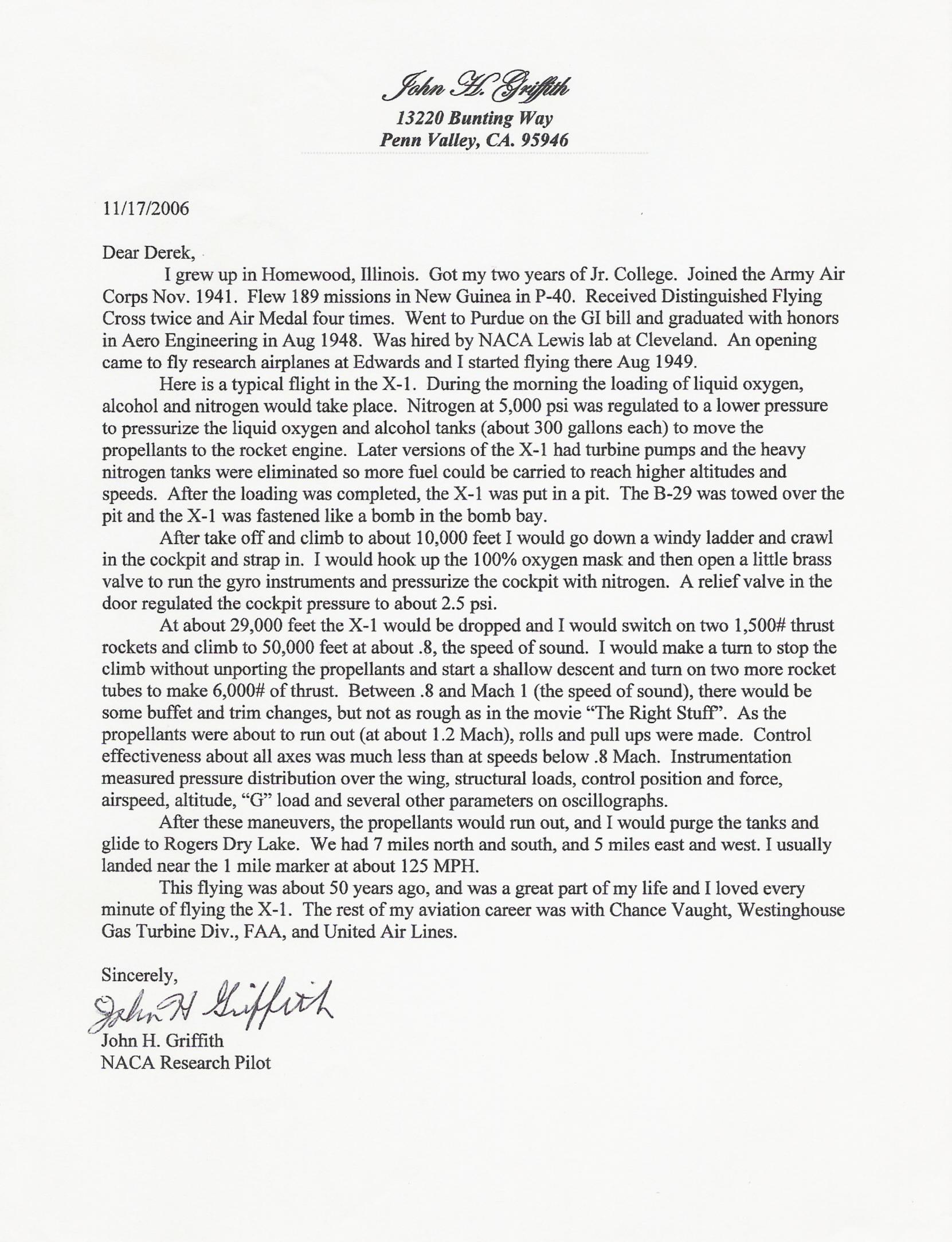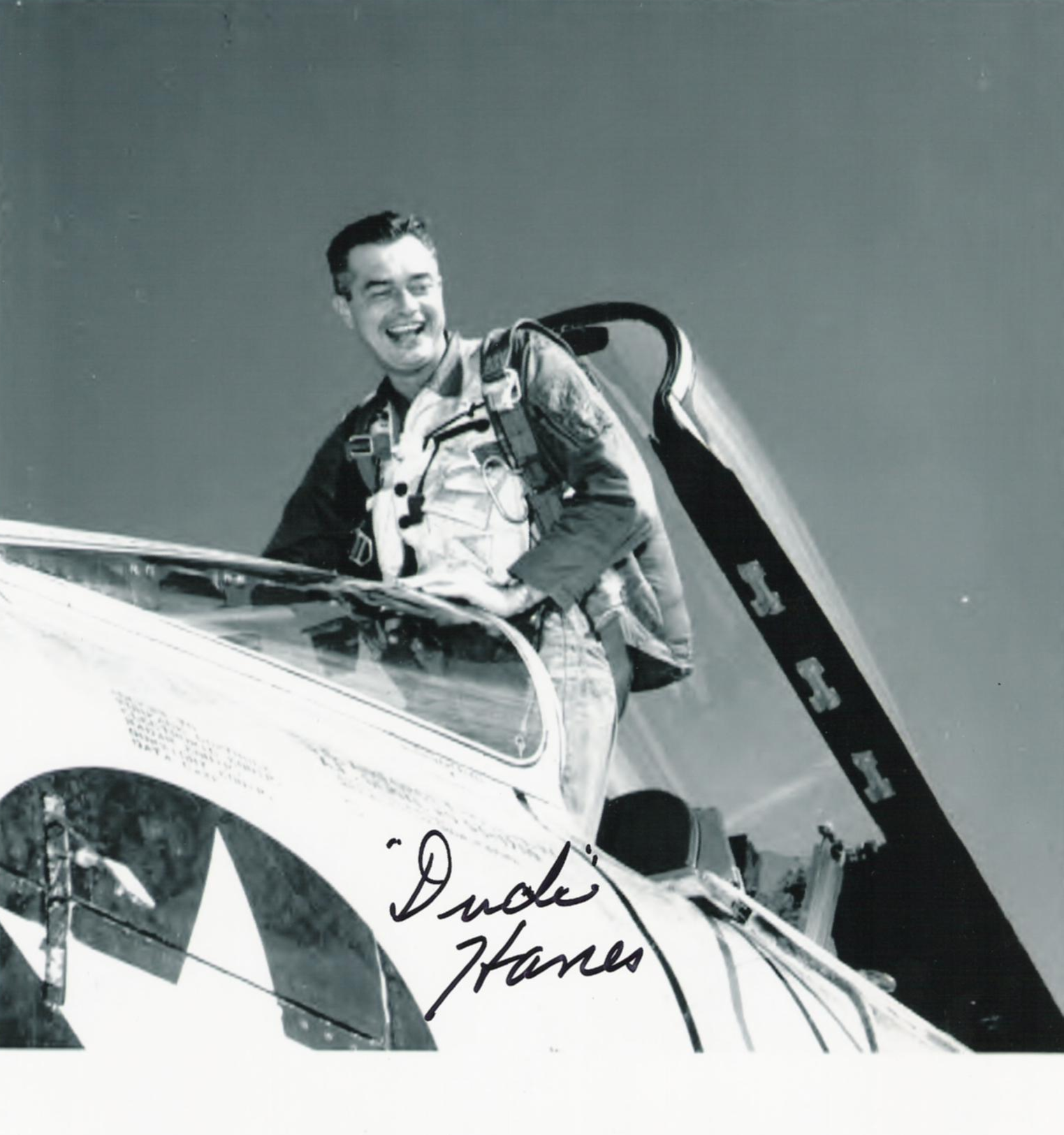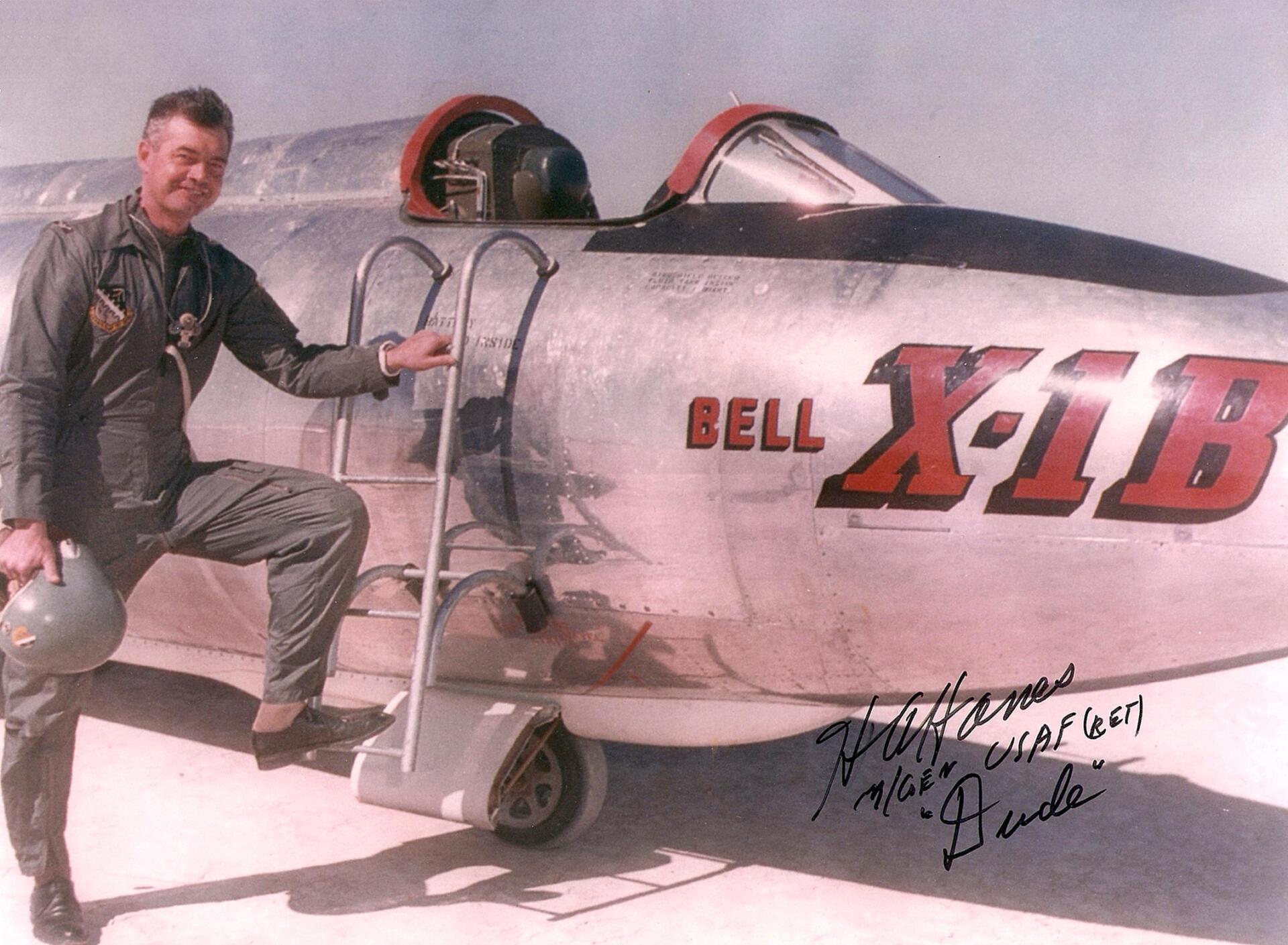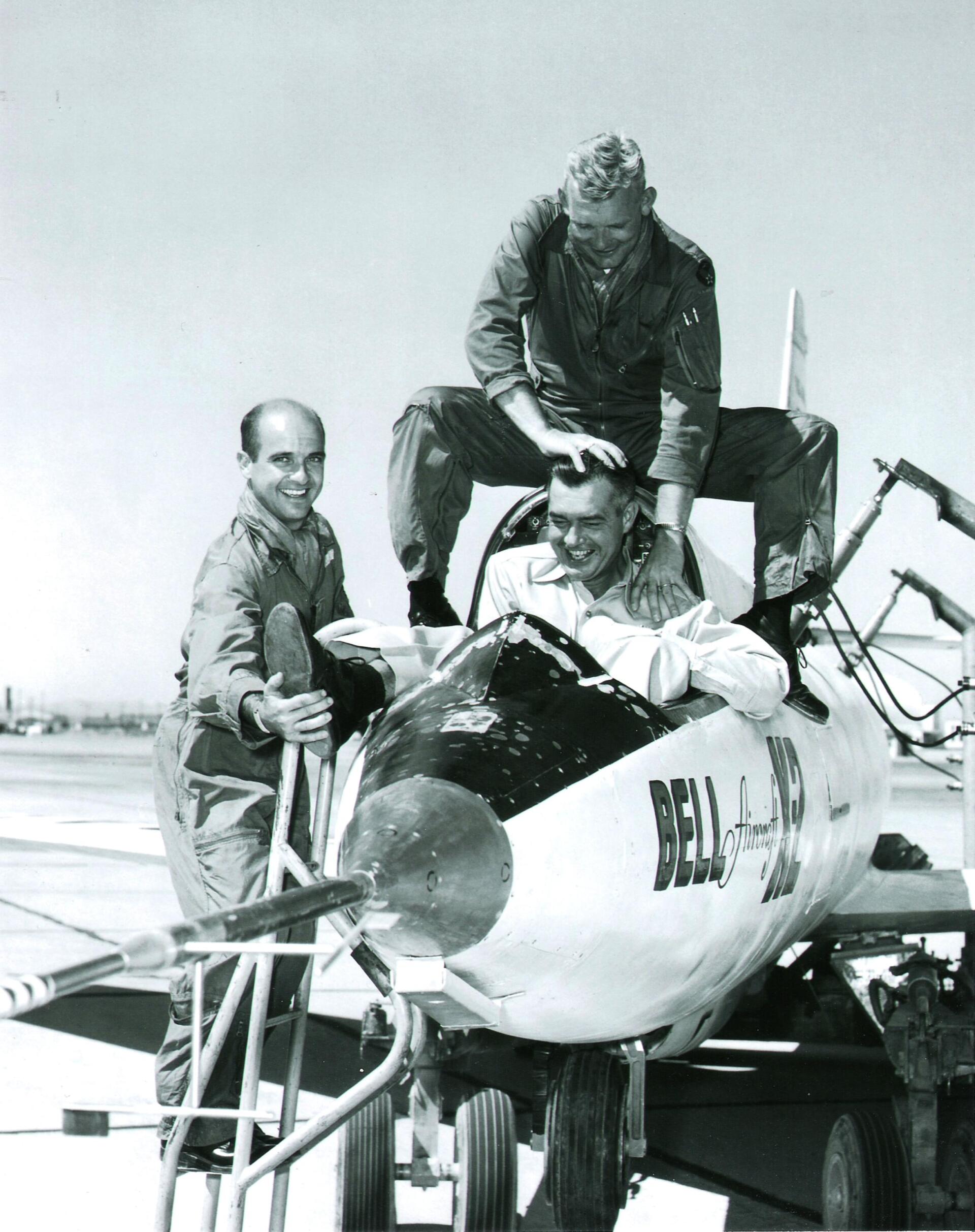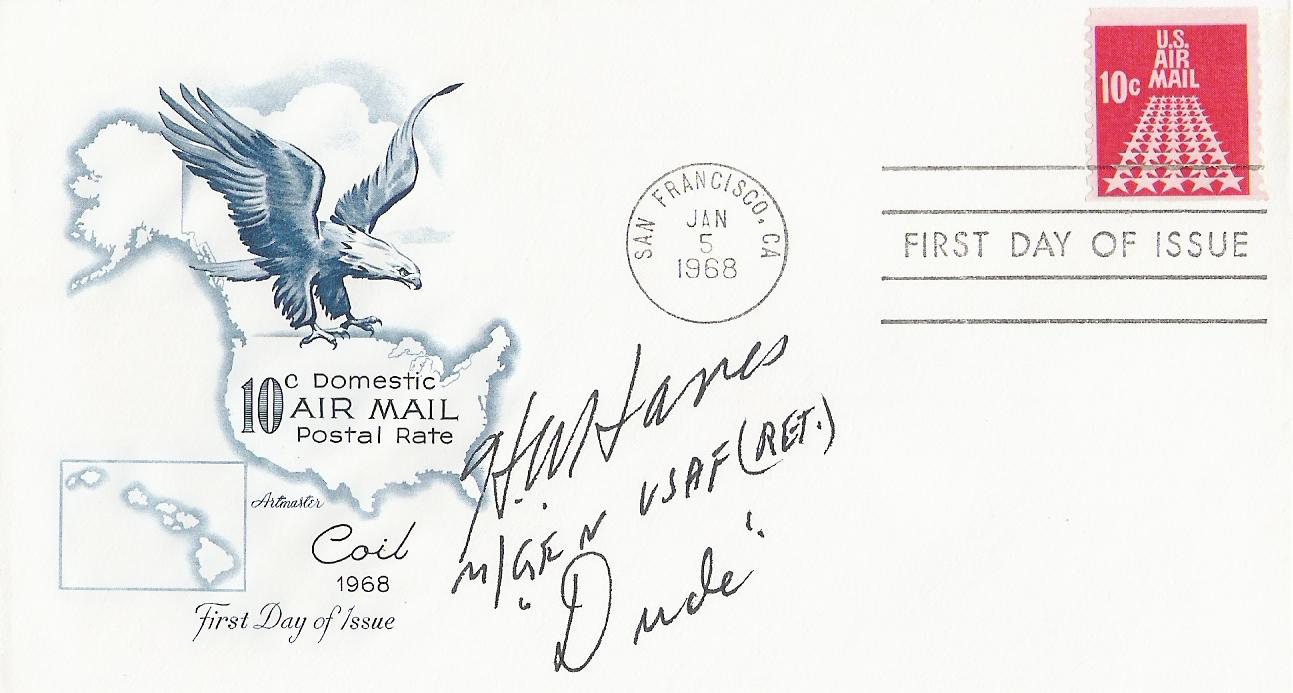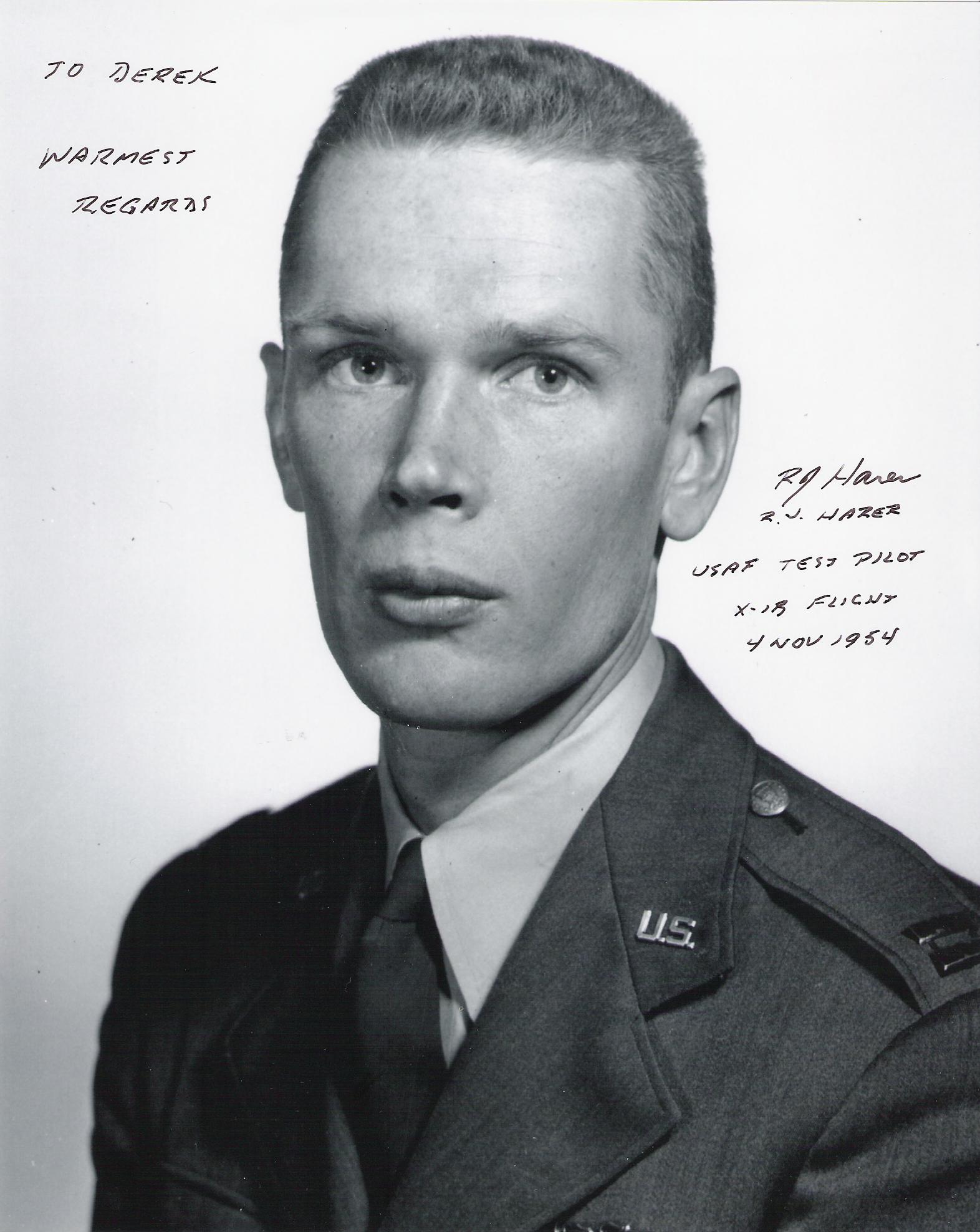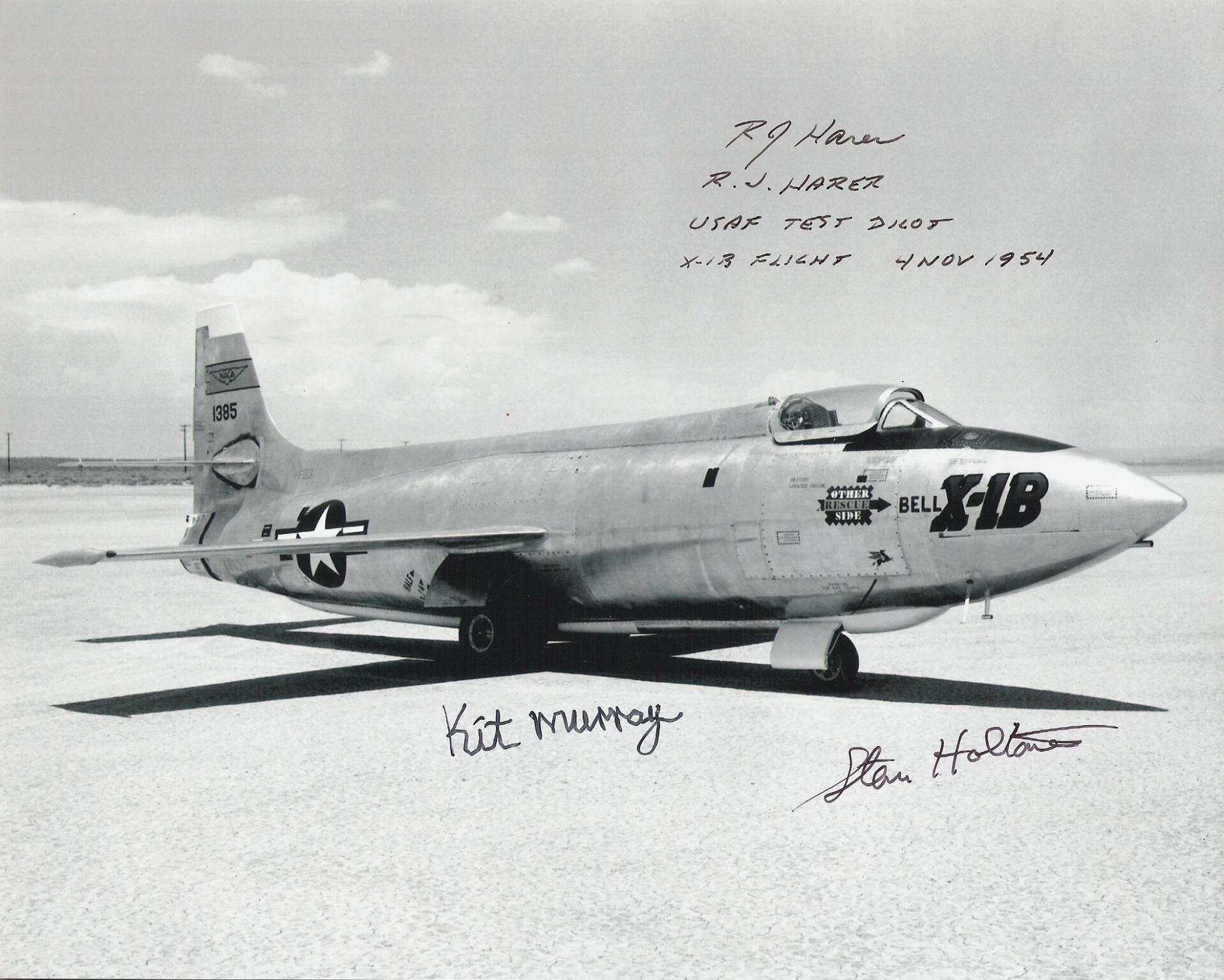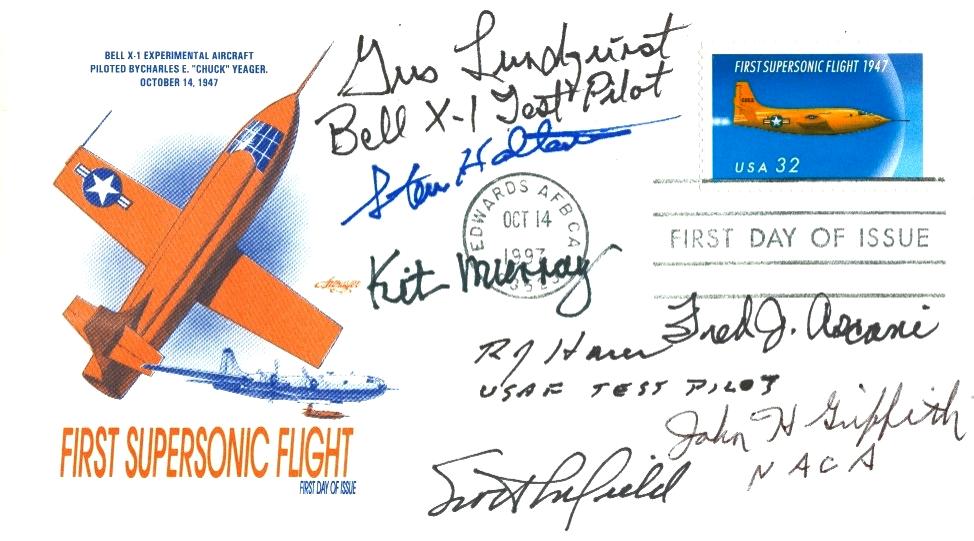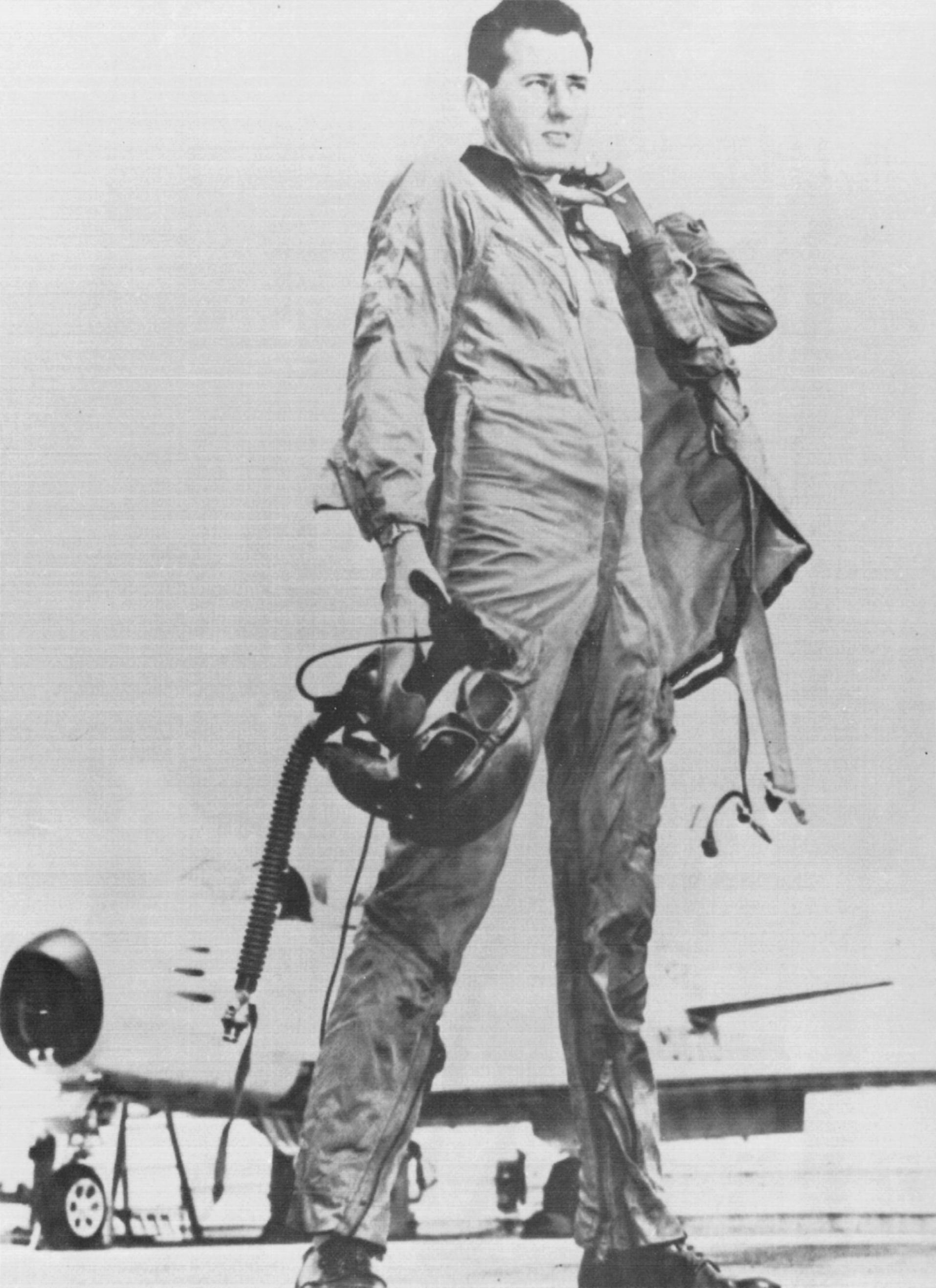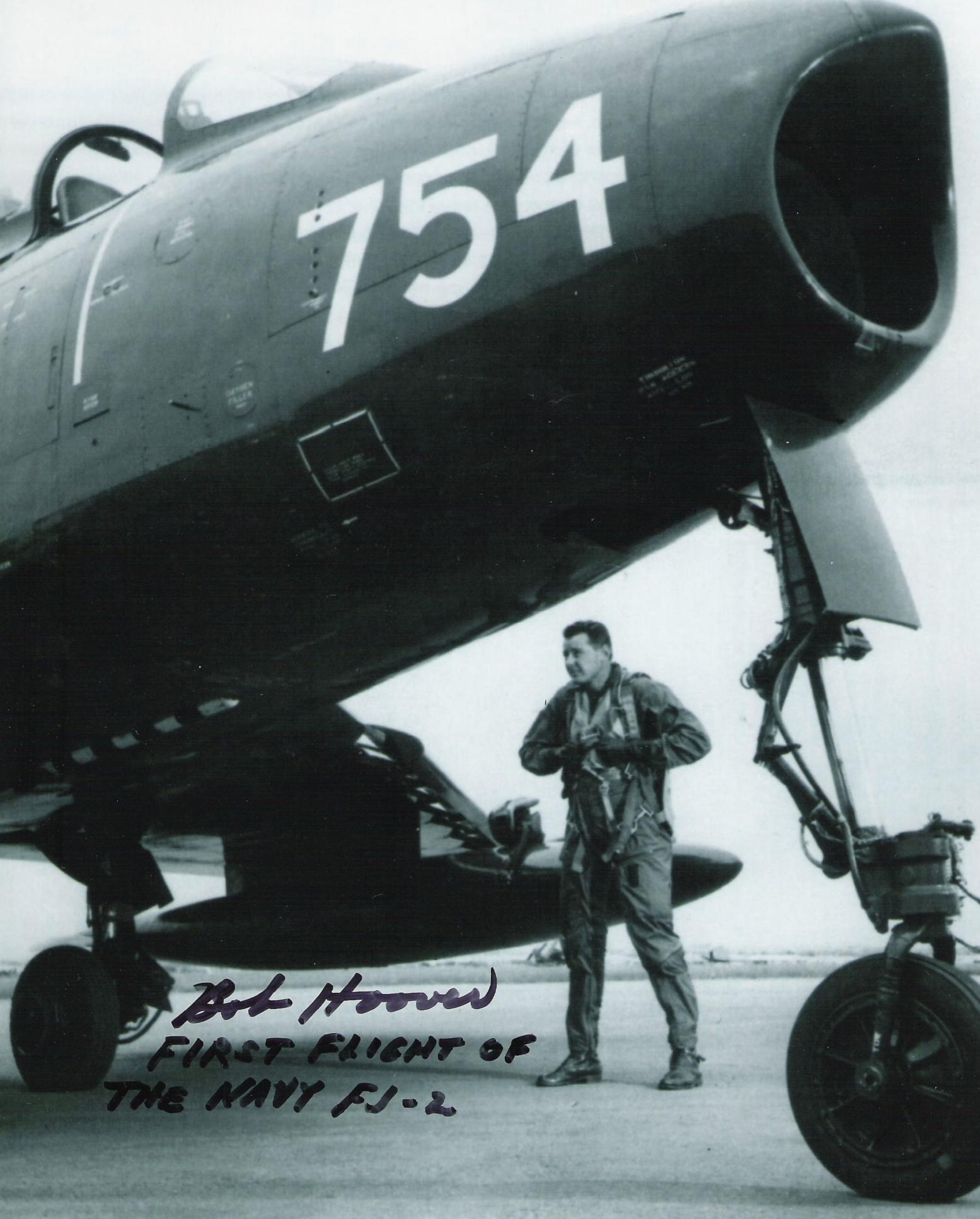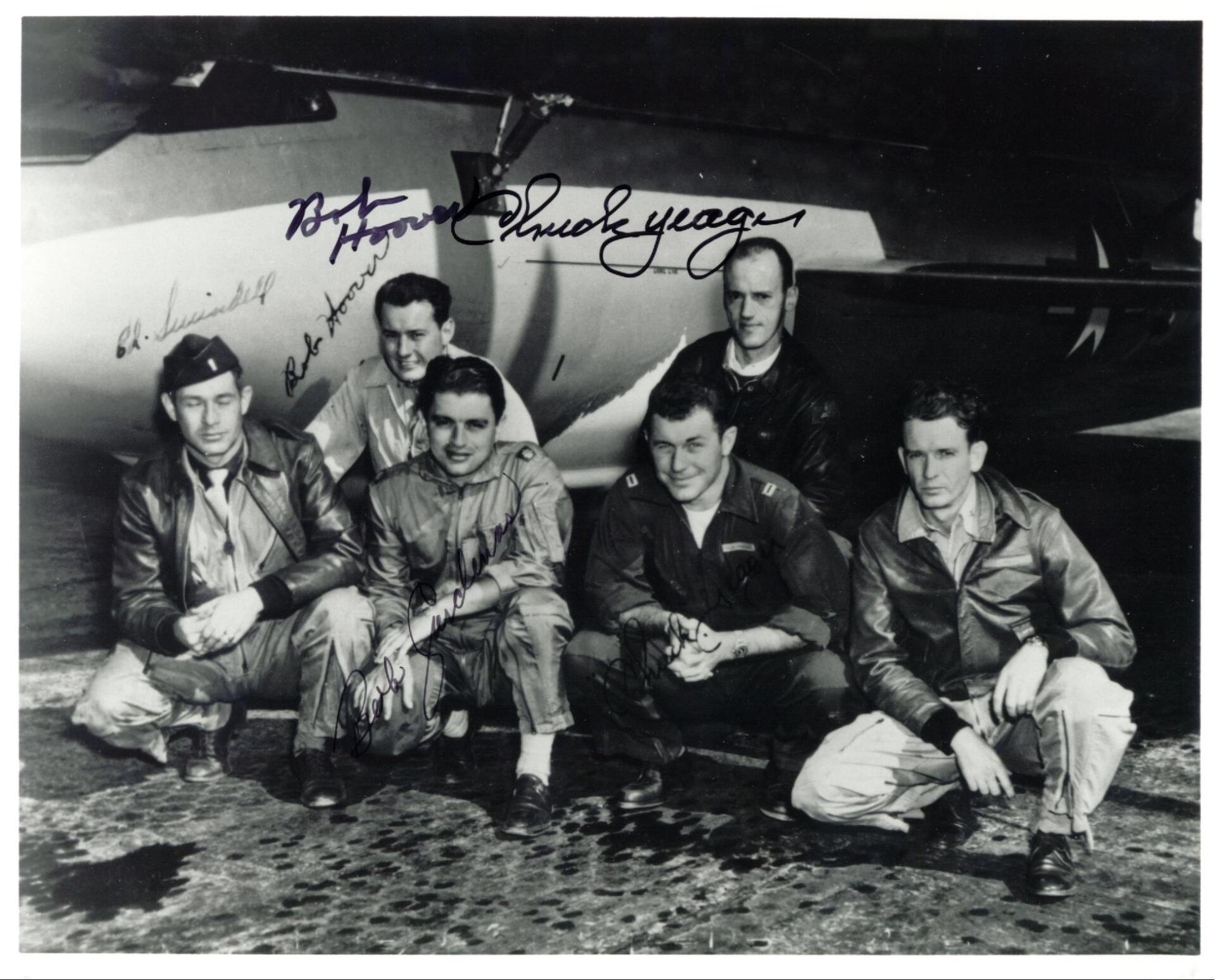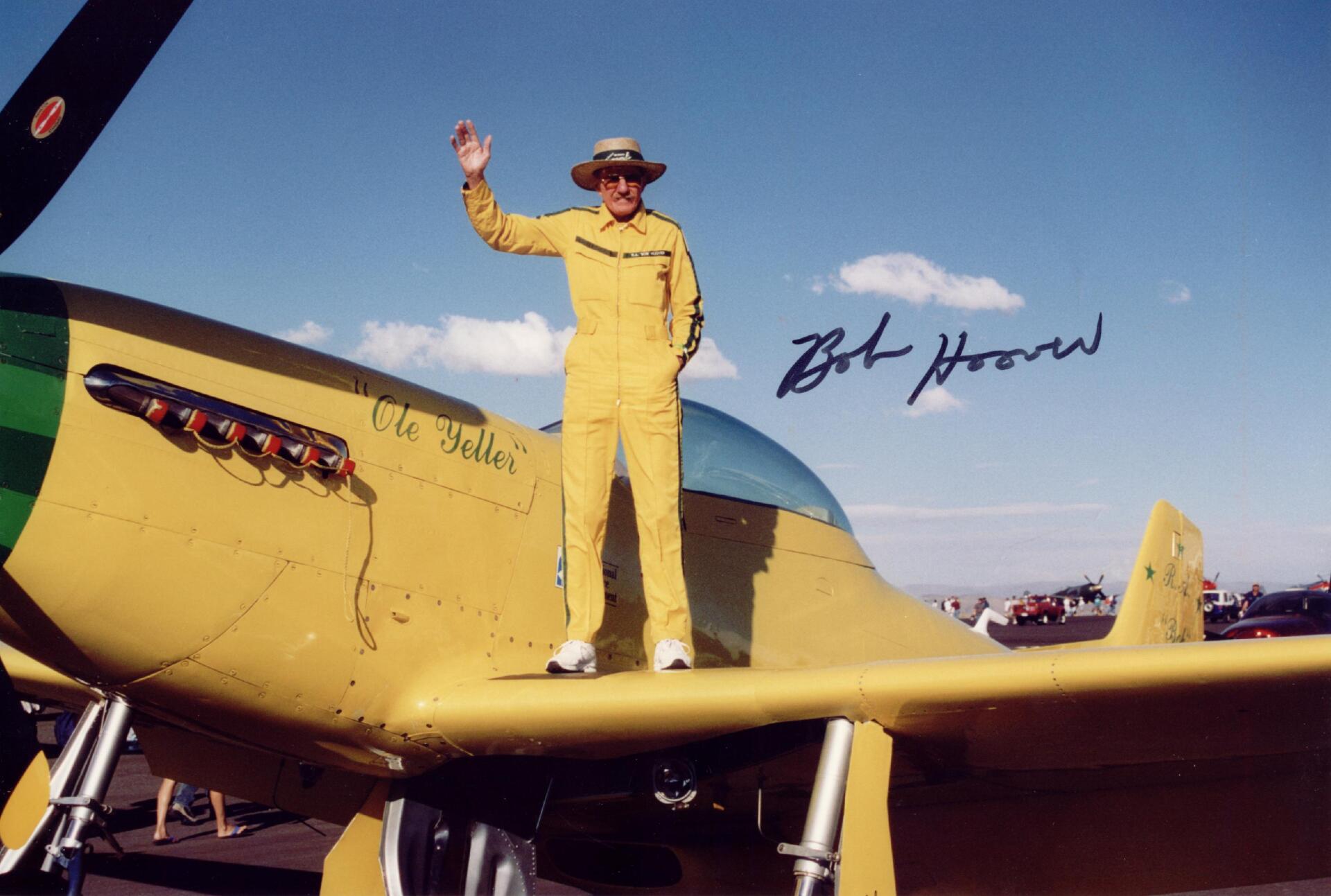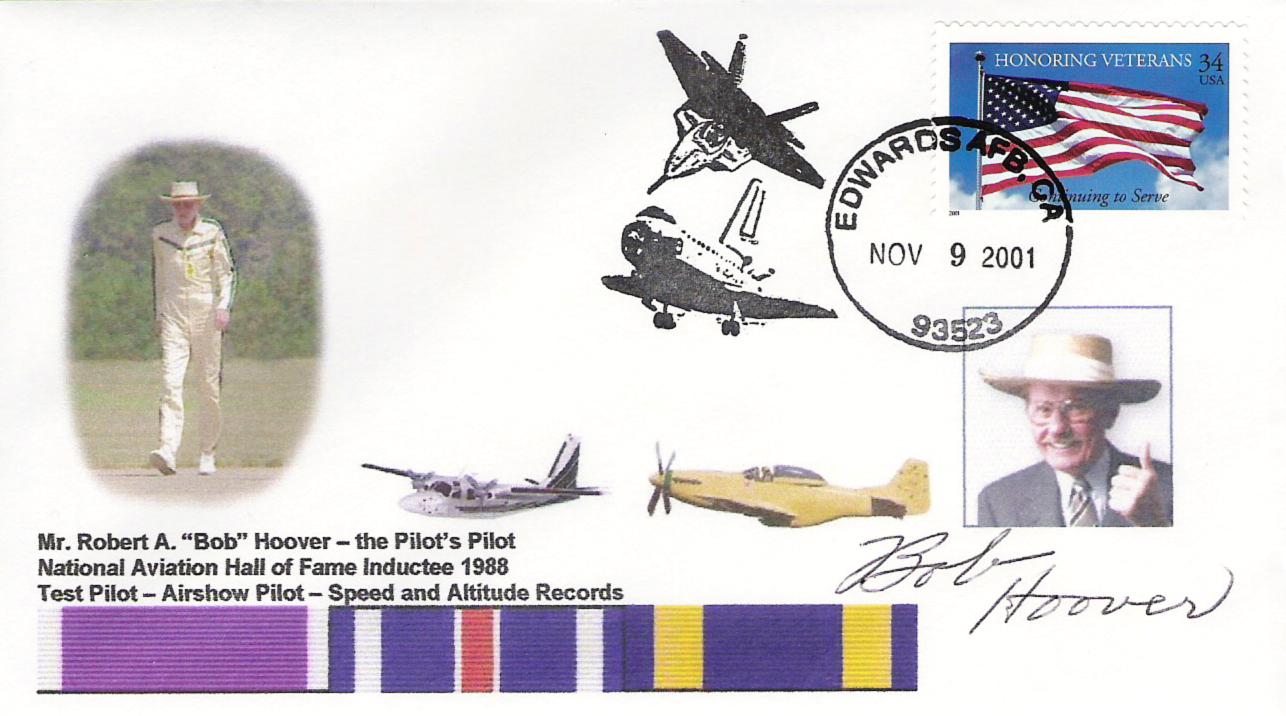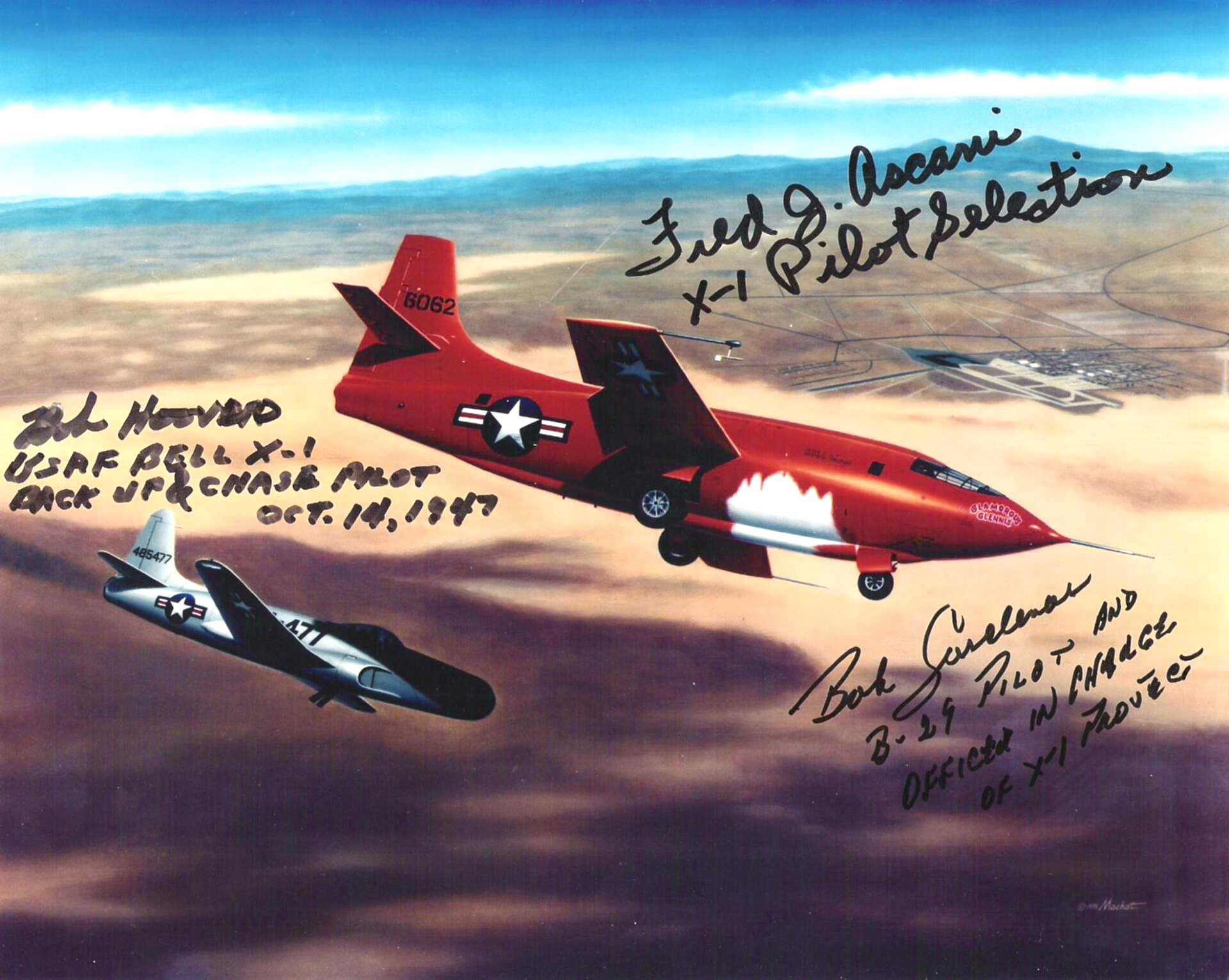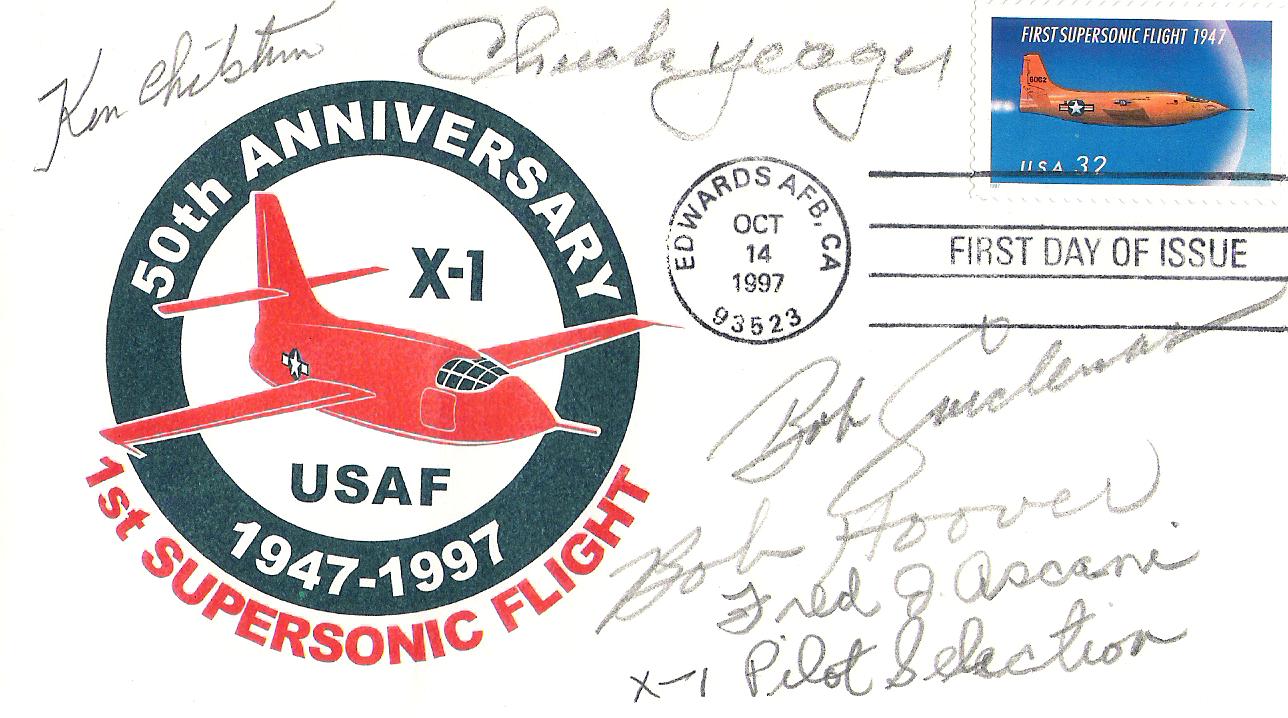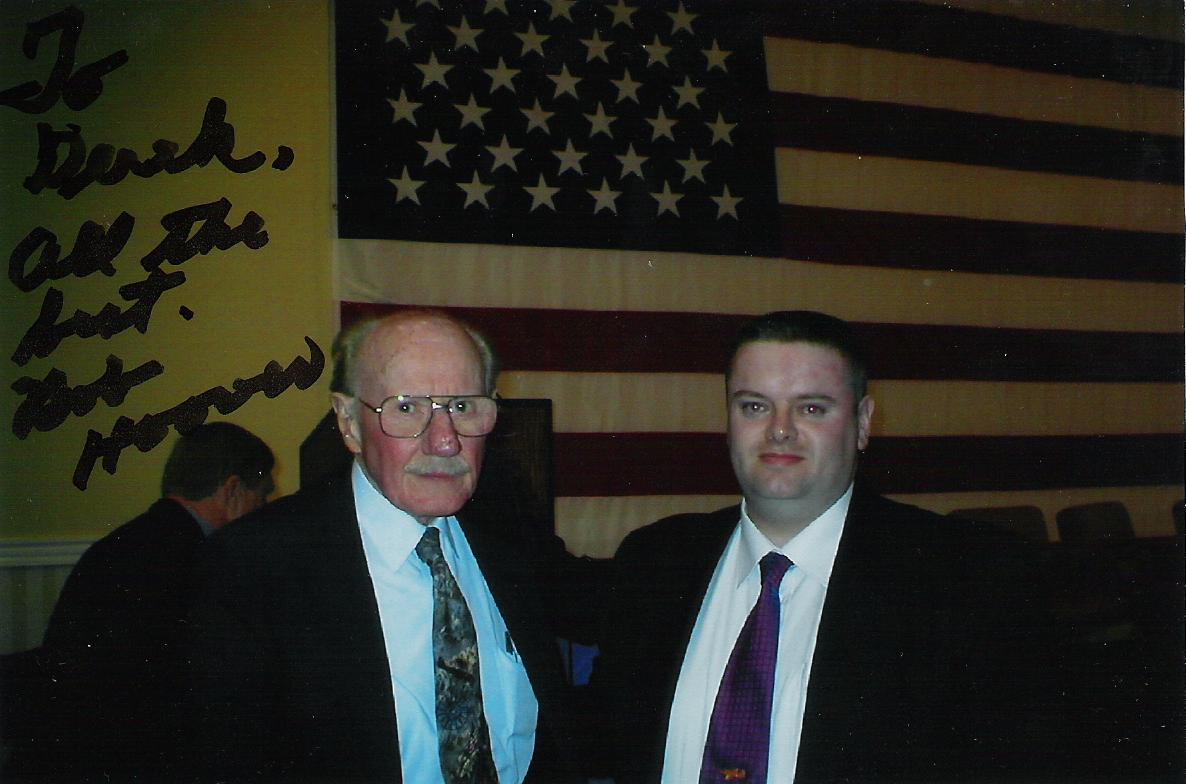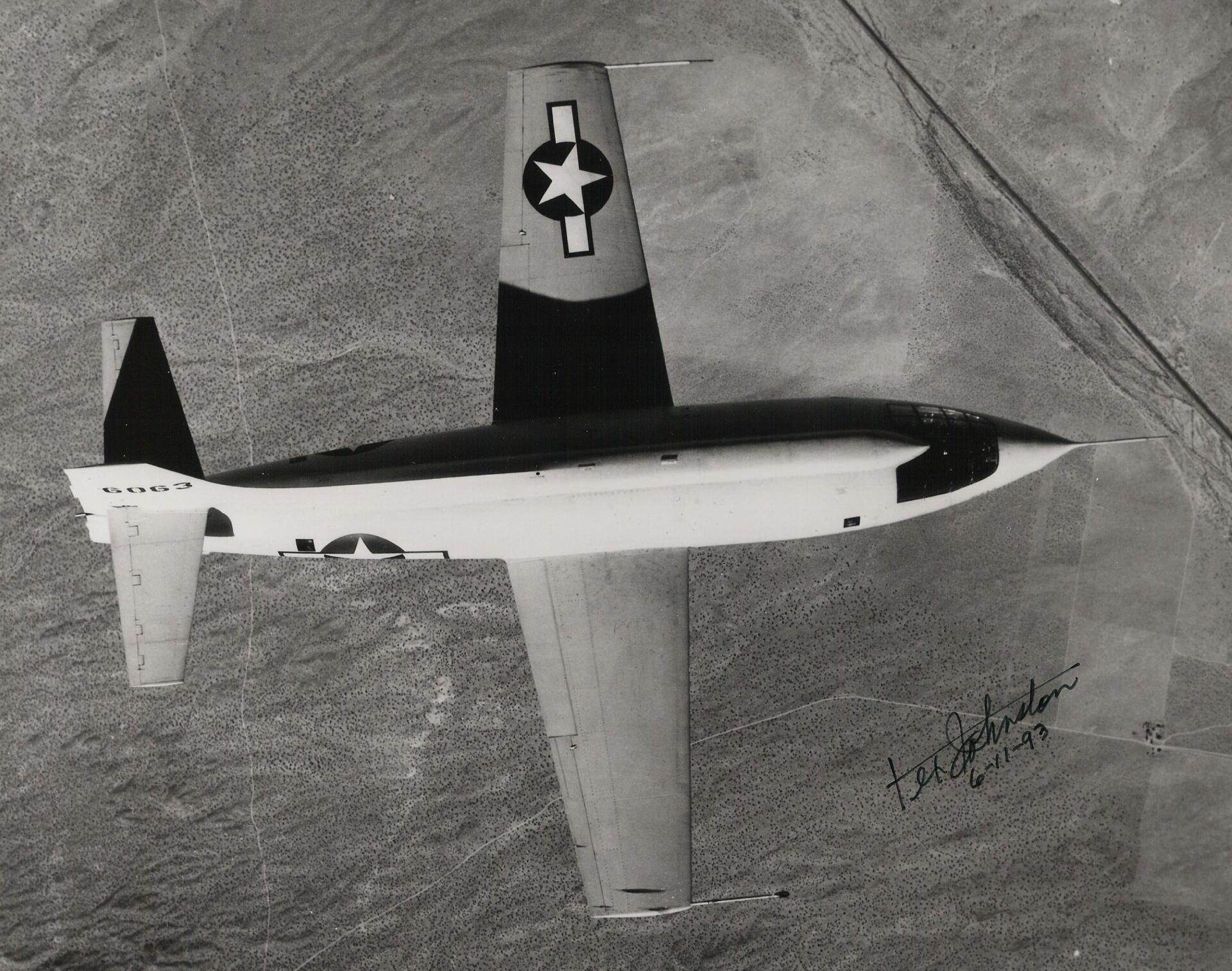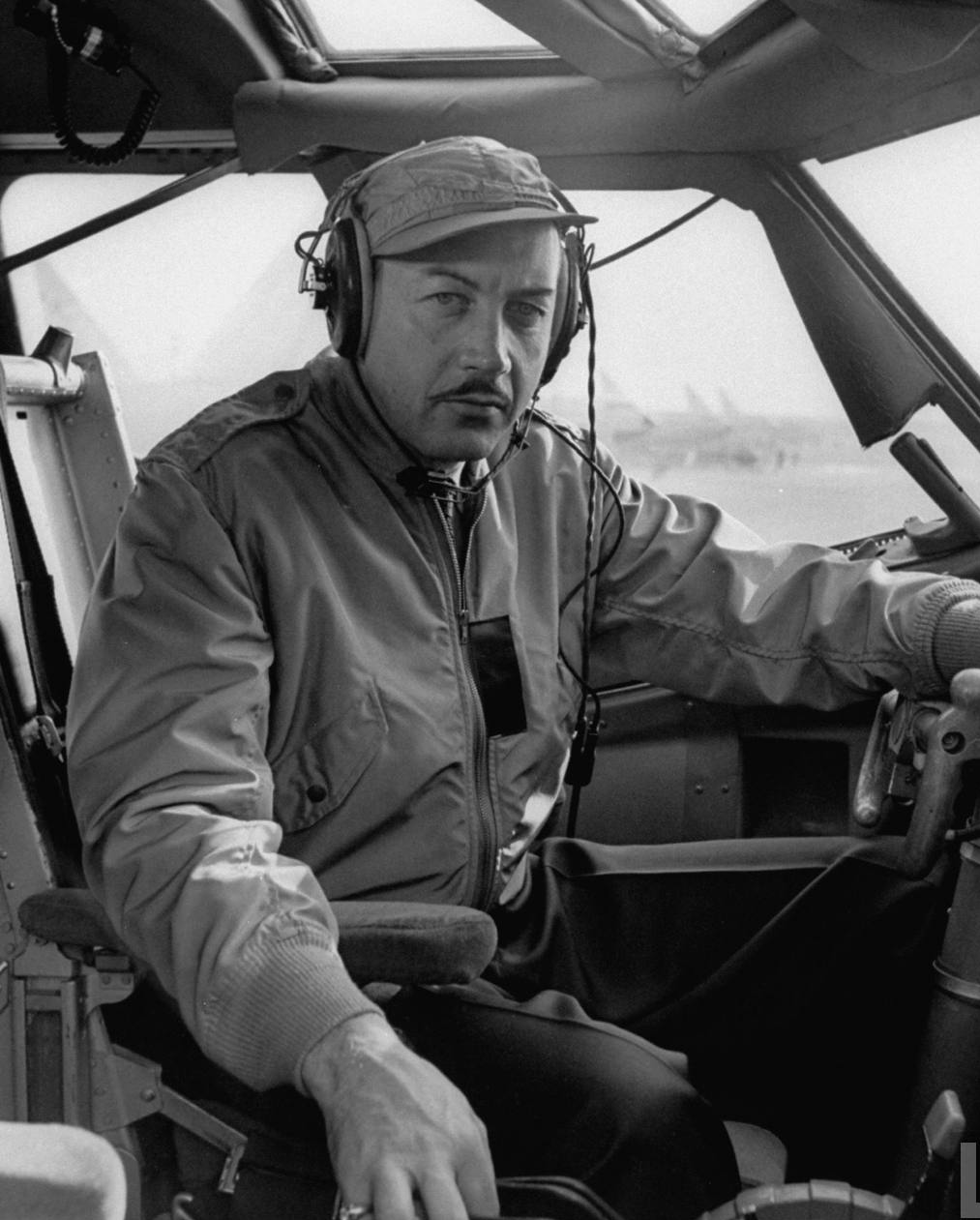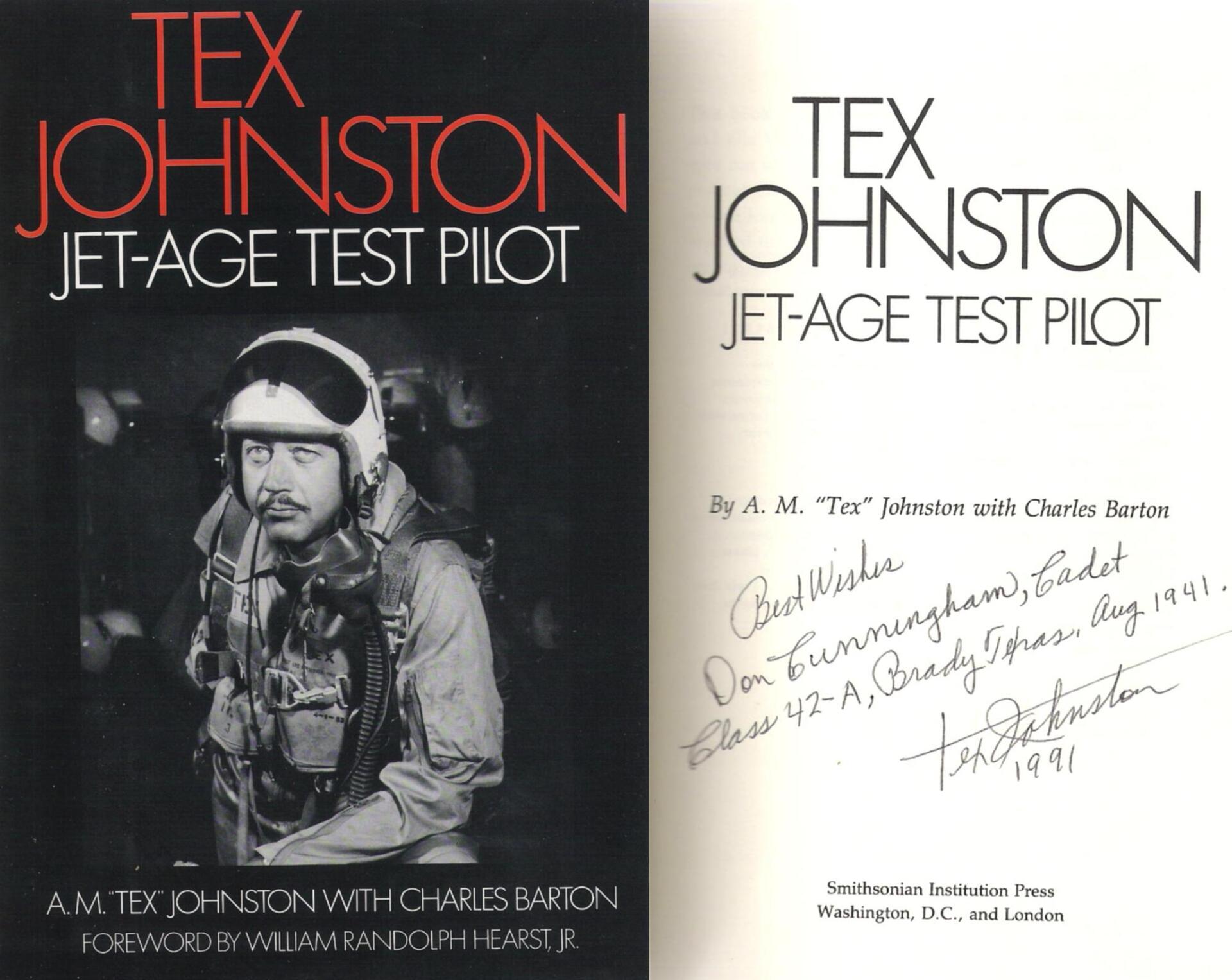Chalmers H, "Slick" Goodlin - (1923-2005)
Chalmers Hubert "Slick" Goodlin is a combat veteran of WWII where he served with the Royal Air Force (on detachment from the Royal Canadian Air Force) flying the Supermarine Spitfire. Goodlin joined the Bell Aircraft Corporation in late 1943 as an engineering test pilot. After the tragic death of Jack Woolams in August 1946; Goodlin was selected to fly the Bell X-1. Goodlin flew his first glide flight on October 11th, 1946 in the #2 X-1 (6063) and made another two glide flights before making the first powered flight in the X-1 program on December 9th 1946. During this period the #1 X-1 (6062) had been returned to the Bell plant for modifications (an 8% thickness/chord wing had been fitted as opposed to the 10% thickness/chord wing of the #2 X-1).
The #1 X-1 returned to Muroc and Goodlin made his first glide in this bird on 10th April 1947. The first powered flight of the #1 X-1 was made by Goodlin on 11th April 1947 and upon landing there was damage to the nosewheel. Goodlin made a further 8 powered flights in the X-1 with the last being on June 5th 1947. The Air Force were unhappy with the progress being made with the envelope expansion flights and called for a more accelerated program. The newly designated US Air Force took over the program from the contractor which left Slick Goodlin out on a limb. He'd been contracted to Bell to take the X-1 out to Mach 1 and as part of that contract was due to receive $150,000 when Mach 1 was reached. A naturaly gifted "stick and rudder man", had the Air Force not taken over the program Goodlin would surely have went on to make the worlds first supersonic flight.
In Tom Wolfe's book "The Right Stuff" some liberties and untruths were written about Slick Goodlin which were further exacerbated in the movie of the same name. In the book and movie (and also in Chuck Yeager's autobiography) its claimed that Slick Goodlin lost his seat in the X-1 due to holding out for the big $150,000 bonus. The author had lengthy dialogue with Slick Goodlin in the years prior to his death and was advised that this simply wasn't true. Slick lost his ride because the Air Force wanted to take over the program and change the way in which Flight Test programs were conducted. Up until the X-1 all aircraft were flown through the performance and envelope expansion by contractor test pilots. From the X-1 program and onwards contractor pilots were only required to prove the stability & control of an aircraft. The performance testing would now be done by the Air Force test pilots. Chalmers "Slick" Goodlin sadly passed away on October 20th 2005, he was 82 years old.
Read Slick's NASA biography.
John H. Griffith - (1921-2011)
John Griffith is a former combat veteran of WWII; flying 189 missions in the P-40 in the Pacific Theatre of Operations in the Army Air Corps. Griffith left the service in 1946.
Griffith joined the NACA's Muroc Flight Test Unit in September 1949 and went on to fly the Bell X-1 nine times, the Northrop X-4 Bantam seven times, the Douglas D-558-I Skystreak fifteen times and the Douglas D-558-II Skyrocket nine times. John Griffith made his fastest flight in the X-1 on May 26, 1950 achieving a maximum Mach number of 1.20 in X-1 #2 (6063). Griffith left the NACA in 1950 to join Chance-Vought testing their F-7U Cutlass. Click here to read John Griffith's NASA DFRC biography.
MGEN Horace A. "Dude" Hanes USAF ret. - (1916-2002)
General Hanes was born in Fayette, Ill., in 1916. After graduating from Normal Community High School in 1933, he attended Illinois State Normal University where he received his bachelor of arts degree in education in 1937. He entered the U.S. Army Air Corps in October 1938, completed flying school at Kelly Field, Texas, and was commissioned a second lieutenant in the U.S. Army Air Corps Reserve in August 1939. In October 1939 he was assigned to the 18th Pursuit Group in Hawaii, and received his commission as second lieutenant in the Regular Army Air Corps in July 1940. He returned to the United States in October 1941, and served with the Air Training Command for five months before being assigned as commander, 312th Fighter Squadron, 338th Fighter Group, flying P-47 aircraft. In August 1943 General Hanes was transferred to the European Theatre of Operations and was assigned to the 1st Fighter Group where he served as commander, 71st Fighter Squadron, then as group operations officer, and lastly as deputy group commander. He completed 30 combat missions in P-38 aircraft before he was reported missing in action over Yugoslavia in January 1944 and spent three months evading capture. He returned to the United States in April 1944 and was assigned as commanding officer of the Fighter Station at Punta Gorda, Florida.
In January 1946 he returned to Europe where he commanded the 31st Fighter Group, the first American group in Germany to be equipped with F-80 Shooting Star aircraft. He remained in Germany until November 1947, when he returned to the United States and was assigned as commander of the 67th Tactical Reconnaissance Group, March Air Force Base, Calif. General Hanes entered the Armed Forces Staff College in January 1949. He was assigned to Headquarters U.S. Air Force, in July 1949, where he served in the Directorate of Research and Development as Chief of the Air Defence Division. He next attended the Air War College at Maxwell Air Force Base, Ala., from July 1952 to June 1953.
He became director of flight test at the Air Force Flight Test Center Edwards Air Force Base, Calif., in July 1953, and served in that capacity for four years. On Aug. 20, 1955, General Hanes set the world's first official supersonic speed record over the Mojave Desert when he flew an F-100C Super Sabre at an average speed of 822.135 mph. He was awarded the Thompson Trophy for his record runs made at an altitude of 40,000 feet. In 1956 he received the Mackay Trophy. General Hanes commanded the 58th Fighter Bomber Wing in Korea from July 1957 to May 1958 and received the Legion of Merit for his exceptionally meritorious service.
For the next three years he was deputy chief of staff, operations, for Fifth Air Force in Japan. He returned to the United States in July 1961 and was assigned as assistant chief of staff, plans, Headquarters Air Defence Command, at Ent Air Force Base, Colorado. He was reassigned as commander of the 9th Aerospace Defence Division in July 1964. In June 1966 General Hanes was assigned to Supreme Headquarters Allied Powers Europe in Paris as assistant chief of staff, operations. He became vice commander of Aerospace Defence Command at Ent Air Force Base, Colorado in August 1969. A command pilot, General Hanes has more than 6,000 flying hours and participated in early development evaluations of many of this nation's aircraft. In addition he has flown the Bell X-1B and several British and French jets. Click here to read General Hanes USAF biography. General Hanes sadly passed away on December 3rd, 2002.
Richard J. Harer - (1924-2019)
Richard J. Harer is a veteran of WWII flying 31 combat missions in the ETO. After graduating from the USAF Test Pilot School in 1949 & 1951 he was assigned to the AFFTC at Edwards AFB on June 14th, 1951 as Experimental Flight Test Officer, Fighter Operations Branch, Flight Test Operations Lab and was assigned as test pilot for the Phase IV performance flight testing of the Republic F-84F fighter-bomber.
Harer took part in the 1954 Bendix race and made one flight in the Bell X-1B on November 4th, 1954. Harer was flying a Lockheed F-94C on a routine test flight on December 22nd, 1954 when he experienced engine trouble and attempted a wheels-up landing on Rogers Dry Lake. The aircraft caught fire upon crash-landing and Harer was stuck in the burning cockpit. Chase pilot Captain Milburn "Mel" Apt immediately landed next to the crashed airplane and pulled Harer from the burning wreckage, saving his life. Harer's injuries included a broken back, third degree burns and a compound fracture of both legs. Unfortunately Captain Harer's legs had to be amputated due to the severity of the injury. After months of recovery he had to retire from active duty but continued to work at Edwards AFB as a civil servant. Harer was the Project Manager for the X-15 program for the entirety of the program from start to finish. Richard Harer sadly passed away on 20th November 2019, he was 95 years old. A more detailed biography is contained in Mr Harer's obituary.
Robert A. "Bob" Hoover - (1922-2016)
Bob Hoover is a combat veteran of WWII, serving in the European Theatre of Operations. After WWII, Hoover was assigned to Wright Field and was personally selected by Colonel Al Boyd to be the backup and high chase pilot for the X-1 program. Hoover never got to fly the X-1 due to breaking both of his legs in a bail out of a Republic F-84 Thunderjet.
Hoover left the Air Force to take up a position with North American Aviation as a test pilot. Bob Hoover is perhaps better known for his legendary displays at airshow's around the world where he wowed audiences with his displays in the Sabreliner, P-51D "Ole Yeller" and in his Shrike Aero Commander. I had the honor and privilege of meeting "The Hoov" at the Flight test Historical Foundation's "Gathering of Eagles" on 24th October 2003. Bob Hoover was considered one of the founding fathers of modern aerobatics and was described by General Jimmy Doolittle as "The greatest stick and rudder pilot who ever lived" and in the Smithsonian's Centennial of Flight edition of "Air & Space/Smithsonian" magazine named as the third greatest aviator in history. Click here to read Bob Hoover's biography on Wikipedia.
Alvin M. "Tex" Johnston - (1914-1998)
A pioneer of the "jet age," Alvin M. "Tex" Johnston is one of America's foremost test pilots. His love of aviation began in 1925, at age 11. In a pasture near his hometown of Emporia, Kansas, he took his first flight in a Hisso-Standard biplane. At age 16, he taught himself to fly and invested his after-school earnings in further flying lessons. Following high school in 1932, Johnston reluctantly enrolled in a teacher's college, but his parents soon helped him transfer to the Spartan School of Aeronautics. First he studied airplane mechanics, but then took up a limited commercial pilot's course. By age 19, he had not only trained as an aircraft and engine mechanic, but had earned his pilot's license. He worked in Inman's Flying Circus and built time flying in a variety of aircraft. Next, he bought a Command-Aire biplane and barnstormed around the country. Marrying in 1935, he enrolled in Kansas State University, earned an instructor pilot rating, and taught in the new Civilian Pilot Training (CPT) program. After Pearl Harbour, he became a civilian ferry pilot for the Army Air Force.
In late 1942, Johnston declined a commission and went to work for Bell Aircraft testing the P-39 Airacobra. After testing a captured Luftwaffe fighter, he moved to Bell's experimental flight test division. He flew Bell's XP-63 King Cobra and also did contract tests on other corporations' fighters until 1943. At Muroc Dry Lake, California, Johnston tested Bell's top-secret jet, the XP-59 Airacomet. In 1946, he modified a war-surplus P-39 and reached speeds of 430 mph while winning the Thompson Trophy at the National Air Races. He also set a new world speed record for closed-course air racing. Next, Johnston supervised Bell's tests of the rocket-powered X-1 until 1947 and made one flight in the X-1 at Muroc on 22nd May 1947. He then worked on Bell's helicopter program until mid-1948.
The whine of jet engines beckoned, and a tip from USAF Colonel Al Boyd sent Johnston to Boeing. He became senior experimental test pilot on the XB-47Stratojet at Wichita. In 1951, he moved to Seattle to become project pilot for Boeing's YB-52 Stratofortress. He made the first flight in the YB-52, a record 3 hours and 8 minutes, on 15 April 1952. Later he flew as co-pilot for General LeMay in the first production aircraft. In 1954, Johnston made the first flight of Model 367-80. The aircraft led to the KC-135 Stratotanker and the 707 airliner. In the early 1960's, Johnston was Assistant Program Manager for Boeing's X-20 Dyna Soar, a precursor to the Space Shuttle. After Secretary of Defence McNamara cancelled the Dyna Soar, he worked 4 years as Director, Boeing Atlantic Test Center, then went into business for himself. Tex Johnston passed away in 1998 from natural causes.
Read Tex Johnston's National Aviation Hall of Fame biography here.

